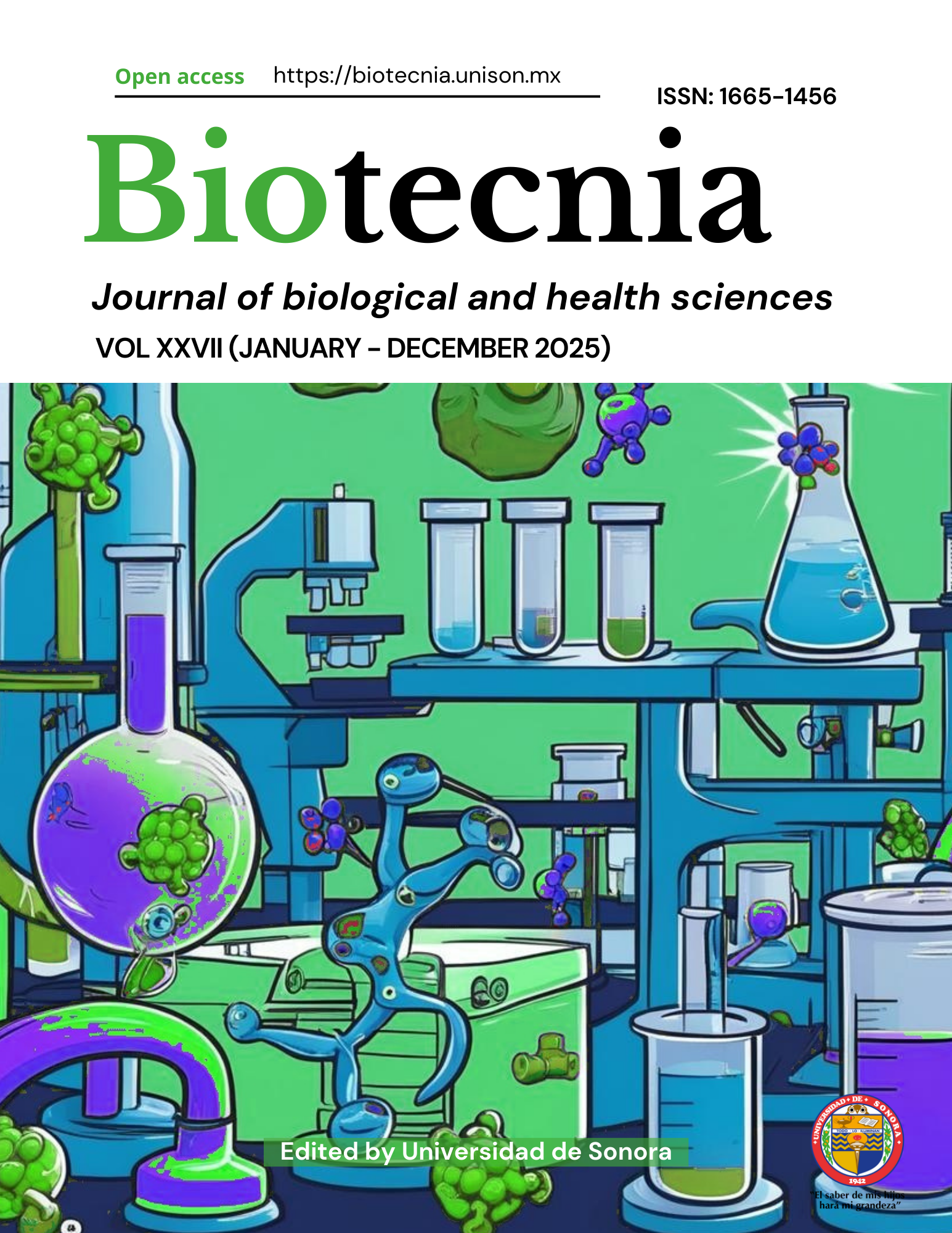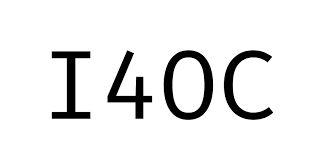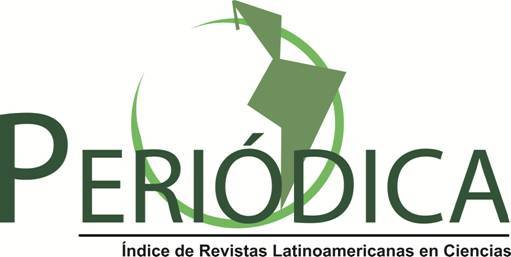Effect of the intercropping system with cowpea (Vigna unguiculata (L.) Walp.) on the agronomic and physiological performance and damage by fall armyworm in three landraces of maize
DOI:
https://doi.org/10.18633/biotecnia.v27.2359Keywords:
policulture, associated crop, maize productionAbstract
The objective of this study was to determine the agronomic and physiological performance of Yucatan landrace maize due to intercropping with cowpea (Vigna unguiculata (L.) Walp.). The experiment was
conducted using a randomized complete block design with three replications. Three lan- drace maize cultivars (Naal teel, Nal xoy and Dzit bacal) were established in both monoculture and in association with
V. unguiculata. Agronomic performance was evaluated by measuring growth variables, yield components, and dama- ge by fall armyworm (Spodoptera frugiperda, Lepidoptera: Noctuidae), as well as physiological variables related to gas exchange. Data obtained were analyzed using Student’s t-test. Maize plants intercropped with V. unguiculata showed the lowest damage levels (damage grade
2.5 to 3) by fall armyworm (S. frugiperda), along with the highest values for physiological variables. Naal teel and Nal xoy maize cultivars established in association had the highest number of filled ears and grain yield (1 to 1.7 tons per ha). On the other hand, growth variables showed no differences between plants established in monoculture and those in association. Inter- cropping V. unguiculata with maize enhances yield and plant physiology, as well as reduces the degree of damage caused by S. frugiperda.
Downloads
References
Ahmad, A.A., Radovich, T.J. and Hue, N.V. 2015. Effect of intercropping three legume species on growth and yield of sweet corn (Zea mays) in Hawaii. Journal of crop improvement. 29(3): 370-378.
Alemayehu, D., Shumi, D. and Afeta, T. 2018. Effect of variety and time of intercropping of common bean (Phaseolus vulgaris L.) with maize (Zea mays L.) on yield components and yields of associated crops and productivity of the system at mid-land of Guji, Southern Ethiopia. Advances in Crop Science and Technology. 6(1): 4-8.
Altieri, M.A. and Nicholls, C.I. 2019. Vegetational designs to enhance biological control of insect pests in agroecosystems. In: Souza, B., Vázquez, L., Marucci, R. (eds) Natural enemies of insect pests in neotropical agroecosystems. Springer, Cham.
Anas, M., Liao, F., Verma, K.K., Sarwar, M.A., Mahmood, A., Chen, Z.L., Li, Q., Zeng, X.P., Liu, Y. and Li, Y.R. 2020. Fate of nitrogen in agriculture and environment: agronomic, eco-physiological and molecular approaches to improve nitrogen use efficiency. Biological Research. 53(1): 2-13.
Araujo, I.T., Zacarin, G.G., de Oliveira, E.S., Bonfanti, L., Guimaraes, N.D.F., Gallo, A.D.S. and Fontanetti, A. 2021. Maize-Crotalaria spectabilis intercropping in organic system and relations with the insect community. Australian Journal of Crop Science. 15(6): 940-947.
Arshad, M. 2021. Fortnightly dynamics and relationship of growth, dry matter partition and productivity of maize based sole and intercropping systems at different elevations. European Journal of Agronomy. 130: 1-10.
Bi, S., Wang, Y., Xu, T., Hu, B., Wang, Z., Hu, F. and Xu, L. 2023. Application potential of push-pull cropping of maize and beans to fall armyworm (Spodoptera frugiperda) management in China. Research Square. 1: 2-12.
Buckley, T.N. 2019. How do stomata respond to water status?. New Phytologist. 224: 21-36.
Dang, K., Gong, X., Zhao, G., Wang, H., Ivanistau, A. and Feng, B. (2020). Intercropping alters the soil microbial diversity and community to facilitate nitrogen assimilation: a potential mechanism for increasing proso millet grain yield. Frontiers in Microbiology.11: 601054.
Davis, F. M., Ng, S.S. and Williams, W. P. 1992. Visual rating scales for screening whorl-stage corn for resistance to fall armyworm. Technical Bulletin Mississippi Agricultural and Forestry Research Experiment Station. 186: 1-9.
de Souza, R.R.N. and Marques, R.N. 2024. Evaluation of resistance of corn varieties to Dalbulus maidis (Delong & Wolcott) (Hemiptera: Cicadellidae). Research Square. 1: 2-16.
Di Rienzo, J.A., Casanoves, F., Balzarini, M.G., González, L., Tablada, M. and Robledo, C.W. 2020. InfoStat versión 2020. Centro de Transferencia InfoStat, FCA, Universidad Nacional de Córdoba, Argentina. http://www.infostat.com.ar
Dong, N., Tang, M.M., Zhang, W.P., Bao, X.G., Wang, Y., Christie, P. and Li, L. 2018. Temporal differentiation of crop growth as one of the drivers of intercropping yield advantage. Scientific Reports. 8(1): 3110.
Dos-Santos, L. F. C., Ruiz-Sánchez, E., Garruña-Hernández, R. and Andueza-Noh, R. H. (2024). Growth and yield of tropical maize landraces and commercial genotypes in Yucatan, Mexico: Ecosistemas y Recursos Agropecuarios. 11(2): 3.
Fan, Y., Wang, Z., Liao, D., Raza, M.A., Wang, B., Zhang, J., Chen, J., Feng, L., Wu, X.L., Liu, C., Yang, W. and Yang, F. 2020. Uptake and utilization of nitrogen, phosphorus and potassium as related to yield advantage in maize-soybean intercropping under different row configurations. Scientific Reports. 10(1): 9504.
González-Esquivel, C.E., Briones-Guzmán, C., Tovar-López, E., López-Ridaura, E.A. and Camacho-Villa, T.C. 2023. Sustainability evaluation of contrasting milpa systems in the Yucatán Peninsula, Mexico. Environment, Development and Sustainability. 12: 1-18
Guera, O.G.M., Castrejón-Ayala, F., Robledo, N., Jiménez-Pérez, A., Sánchez-Rivera, G., Salazar-Marcial, L. and Flores-Moctezuma, H.E. 2021. Effectiveness of push–pull systems to fall armyworm (Spodoptera frugiperda) management in maize crops in Morelos, Mexico. Insects. 12(4): 298.
Guzzon, F., Arandia-Rios, L.W., Caviedes-Cepeda, G.M., Céspedes-Polo, M., Chavez-Cabrera, A., Muriel-Figueroa, J., Medina-Hoyos, A.E., Jara Calvo, T.W., Molnar, T.L., Narro-León, L.A., Narro-León, T.P., Mejía-Kerguelén, S.L., Ospina-Rojas, J.G., Vázquez, G., Preciado-Ortiz, R.E., Zambrano, J.L., Palacios-Rojas, N. and Pixley, K.V. 2021. Conservation and use of Latin American maize diversity: Pillar of nutrition security and cultural heritage of humanity. Agronomy. 11(1): 172.
Hailu, G., Niassy, S., Zeyaur, K. R., Ochatum, N. and Subramanian, S. 2018. Maize-legume intercropping and push-pull for management of fall armyworm, stemborers, and striga in Uganda. Agronomy Journal. 110(6): 2513-2522.
Kebede, E. 2021. Contribution, utilization, and improvement of legumes-driven biological nitrogen fixation in agricultural systems. Frontiers in Sustainable Food Systems. 5: 2-16.
Kirova, E. and Kocheva, K. 2021. Physiological effects of salinity on nitrogen fixation in legumes – a review. Journal of Plant Nutrition. 44(17): 1-7.
Lawson, T., Terashima, I., Fujita, T. and Wang, Y. 2018. Coordination Between Photosynthesis and Stomatal Behavior. In: Adams III, W., Terashima, I. (eds) The Leaf: A Platform for Performing Photosynthesis. Advances in Photosynthesis and Respiration, Vol. 44. Springer.
Li, L., Zou, Y., Wang, Y., Chen, F. and Xing, G. 2022. Effects of corn intercropping with soybean/peanut/millet on the biomass and yield of corn under fertilizer reduction. Agriculture. 12(2): 1-21.
Li, Y., Wang, L., Zhao, B., Liu, P., Zhang, J., Dong, S. and Shi, D. 2023. Crop productivity, economic advantage, and photosynthetic characteristics in a corn-peanut intercropping system. Agronomy. 13(2): 509.
Librán-Embid, F., Olagoke, A. and Martin, E.A. 2023. Combining milpa and push-pull technology for sustainable food production in smallholder agriculture. A review. Agronomy for Sustainable Development. 43: 7-16.
Lv, Y., Francis, C., Wu, P.T., Chen, X.L. and Zhao, X.N. 2014. Maize-soybean intercropping interactions above and below ground. Crop Science. 54: 914-922.
Manasa, P., Maitra, S. and Barman, S. 2020. Yield attributes, yield, competitive ability and economics of summer maize-legume intercropping system. International Journal of Agriculture, Environment and Biotechnology. 13(1): 33-38.
Manasa, P., Maitra, S. and Reddy, M.D. 2018. Effect of summer maize-legume intercropping system on growth, productivity and competitive ability of crops. International Journal of Management, Technology and Engineering. 8(12): 2871-2875.
Manasa, P., Sairam, M. and Maitra, S. 2021. Influence of maize-legume intercropping system on growth and productivity of crops. International Journal of Bioresources. 8(1): 21-28.
Margalef, O., Sardans, J., Fernández-Martínez, M., Molowny-Horas, R., Janssens, I. A., Ciais, P., Goll, D., Richter, A., Obersteiner, M., Asensio, D. and Peñuelas, J. 2017. Global patterns of phosphatase activity in natural soils. Scientific reports. 7(1): 1337.
Mndzebele, B., Ncube, B., Fessehazion, M., Mabhaudhi, T., Amoo, S., du Plooy, C., Venter, S. and Modi, A. 2020. Effects of cowpea-amaranth intercropping and fertiliser application on soil phosphatase activities, available soil phosphorus, and crop growth response. Agronomy. 10(1): 79.
Mutyambai, D. M., Niassy, S., Calatayud, P. A. and Subramanian, S. 2022. Agronomic factors influencing fall armyworm (Spodoptera frugiperda) infestation and damage and its co-occurrence with stemborers in maize cropping systems in Kenya. Insects. 13(3): 6-18.
Orozco-Ramírez, Q., Ross-Ibarra, J., Santacruz-Varela, A. and Brush, S. 2016. Maize diversity associated with social origin and environmental variation in Southern Mexico. Heredity. 116: 477-484.
Palacios-Rojas, N., McCulley, L., Kaeppler, M., Titcomb, T.J., Gunaratna, N.S., Lopez-Ridaura, S. and Tanumihardjo, S.A. 2020. Mining maize diversity and improving its nutritional aspects within agro-food systems. Food Sciencie and Food Safety. 19: 1809-1834.
Pierre, J.F., Latournerie-Moreno, L., Garruña, R., Jacobsen, K.L., Laboski, C.A., Us-Santamaría, R. and Ruiz-Sánchez, E. 2022. Effect of maize-legume intercropping on maize physio-agronomic parameters and beneficial insect abundance. Sustainability. 14(19): 6-10.
Raza, M.A., Bin Khalid, M.H., Zhang, X., Feng, L. Y., Khan, I., Hassan, M.J., Ahmed, M., Ansar, M., Chen, Y.K., Fang, F.Y., Yang, F. and Yang, W. 2019. Effect of planting patterns on yield, nutrient accumulation and distribution in maize and soybean under relay intercropping systems. Scientific reports. 9(1): 4947.
Reyes-Santiago, E., Bautista-Mayorga, F. and García-Salazar, J.A. 2022. Análisis del Mercado de maíz en México desde una perspectiva de precios. Acta universitaria. 32: e3265.
Rodríguez-Bustos, L., Galicia, L., Benítez, M., Palacios-Rojas, N. and Ramos, I. 2023. Implementing the nature's contributions framework: A case study based on farm typologies in small-scale agroecosystems from the Mexico highlands. Frontiers in Sustainable Food Systems. 7: 1009447.
Ruiz-Santiago, R.R., Ballina-Gómez, H.S., Ruiz-Sánchez, E. Martínez-Fálcon, A.P., Andueza-Noh, R.H., Garruña-Hernandez, R., and Gonzales-Moreno, A. 2024. Functional leaf traits of maize landraces with low and high susceptibility to damage by Spodoptera frugiperda (Lepidoptera: Noctuidae). International Journal of Tropical Insect Science. 44(4): 1953-1963.
Santos, L.F., Andueza-Noh, R.H., Ruíz, E. S., Moreno, L.L., Garruña, R., Mijangos-Cortes, J.O. and Martínez-Castillo, J. 2018. Characterization of the genetic structure and diversity of maize (Zea mays L.) landrace populations from Mexico. Maydica. 62(2): 7-10.
Schwember, A.R., Schulze, J., Del Pozo, A. and Cabeza, R.A. 2019. Regulation of symbiotic nitrogen fixation in legume root nodules. Plants. 8(9): 1-10.
SIAP (Servicio de Información Agroalimentaria y Pesquera). 2021. Producción agrícola. Gobierno de México. https://www.gob.mx/siap/acciones-y-programas/produccion-agricola-33119
Sobhy, I. S., Tamiru, A., Chiriboga Morales, X., Nyagol, D., Cheruiyot, D., Chidawanyika, F., Subramanian, S., Midega-Charles, A.O., Bruce-Toby J.A. and Khan Zeyaur R. 2022. Bioactive volatiles from push-pull companion crops repel fall armyworm and attract its parasitoids. Frontiers in Ecology and Evolution. 10: 1-14.
Tanyi, C.B., Nkongho, R. N., Okolle, J.N., Tening, A.S. and Ngosong, C. 2020. Effect of intercropping beans with maize and botanical extract on fall armyworm (Spodoptera frugiperda) infestation. International Journal of Agronomy. 2020: 2-6.
Udayakumar, A., Shivalingaswamy, T.M. and Bakthavatsalam, N. 2021. Legume-based intercropping for the management of fall armyworm, Spodoptera frugiperda L. in maize. Journal of Plant Diseases and Protection. 128: 2-4.
Ureta, C., González E.J., Espinosa, A., Trueba, A., Piñeyro-Nelson, A. and Álvarez-Buylla, E.R. 2020. Maize yield in Mexico under climate change. Agricultural Systems. 177: 102697.
Wall, S., Vialet-Chabrand, S., Davey, P., Van Rie, J., Galle, A., Cockram, J. and Lawson, T. 2022. Stomata on the abaxial and adaxial leaf surfaces contribute differently to leaf gas exchange and photosynthesis in wheat. New Phytologist. 235: 1743-1756.
Wangiyana, W., Farida, N. and Ngawit, I.K. 2021. Effect of peanut intercropping and mycorrhiza in increasing yield of sweet corn yield. Earth and Environmental Science. 648(1): 1-6.
Xue, Y., Xia, H., Christie, P., Zhang, Z., Li, L. and Tang, C. 2016. Crop acquisition of phosphorus, iron and zinc from soil in cereal/legume intercropping systems: a critical review. Annals of Botany. 117(3): 363-377.
Zhang, C., Dong, Y., Tang, L., Zheng, Y., Makowski, D., Yu, Y., Zhang, F. and van der Werf, W. 2019. Intercropping cereals with faba bean reduces plant disease incidence regardless of fertilizer input; a meta-analysis. European Journal of Plant Pathology. 154: 931-942.
Zhu, Q.L., Xiang, R., Tang, L. and Long, G.Q. 2018. Effects of intercropping on photosynthetic rate and net photosynthetic nitrogen use efficiency of maize under nitrogen addition. Chinese Journal of Plant Ecology. 42(6): 672-680.
Ziaie-Juybari, Pirdashti, H., Abo-Elyousr, K.A.M. and Mottaghian, A. 2021. Abiotic benefits of intercropping legumes and maize to reduce pests. Archives of Phytopathology and Plant Protection. 54(17): 1539-1552.
Downloads
Published
How to Cite
Issue
Section
License
Copyright (c) 2025

This work is licensed under a Creative Commons Attribution-NonCommercial-ShareAlike 4.0 International License.
The journal Biotecnia is licensed under the Attribution-NonCommercial-ShareAlike 4.0 International (CC BY-NC-SA 4.0) license.

















_(2).jpg)







